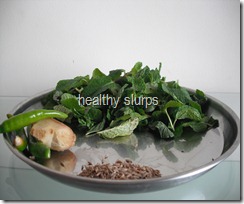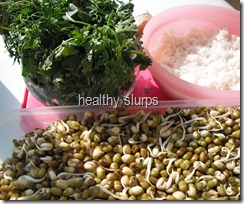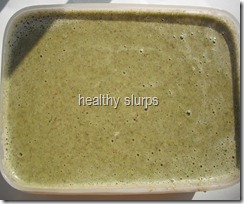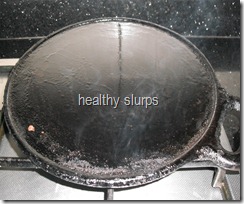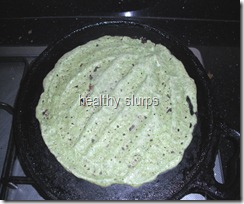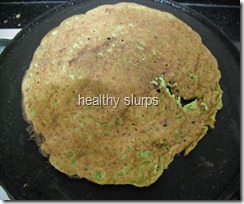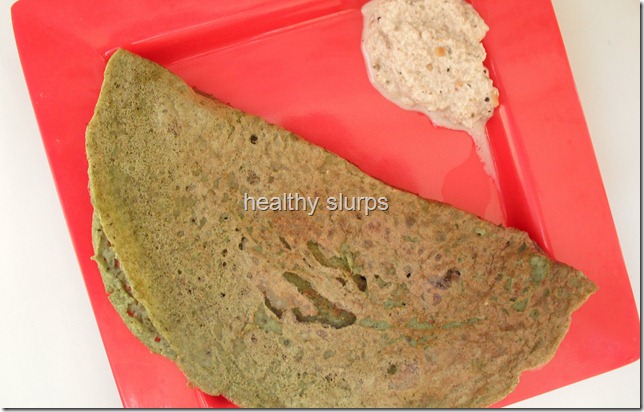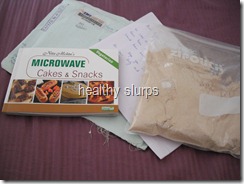 Arusuvai friendship chain season II is here. Hurrah to Sayantani for reviving it. This friendship chain was kick started by Lathamma and Srivalli and Bharthi took it forward.
Arusuvai friendship chain season II is here. Hurrah to Sayantani for reviving it. This friendship chain was kick started by Lathamma and Srivalli and Bharthi took it forward.
I received my mystery parcel from Jayashree. Thank you very much, Jayashree for the lovely hand written note and the very apt book on baking. The mystery ingredient was a pouch of flour. I had to rack my brains to find the mystery ingredient. Finally it turned out to be Rajgira flour / Amaranth flour. I was very eager to create a recipe with this flour as I have not used it in my cookery so far. Upon searching for recipes with Rajgira in the internet, I came across several ‘farali’ (recipes used during religious fasts) recipes in the Indian cuisine and several Mexican dishes too! That’s when my brain started whizzing. So here is a recipe which I created exclusively for the Arusuvai chain.
If I have managed to arouse your curiosity about the strange title, I’m happy. This dish has to be the ultimate product of my fevered imagination… I did not want the usual roti /puri recipes. As if on cue, my daughter walked in complaining that I have not treated her in a long time to her favourite version of pizza – conizza. So a cone base, fillings, burritos ( from Mexican cuisine) – all of them swam around in my head until I came up with this potpourri. The result is here for all – please do give me your feedback on the recipe.
At a recent meet of the Indian Dietetic Association, Bangalore Chapter, Rajgira and several other millets took centre stage. Nutritionists are eager to promote the use of millets in urban diets. By creating a fun, glamorous, and healthy recipe using an age –old ingredient, I hope to do my bit to promote use of such millets in our urban diets replete with polished cereals and other low fibre foods. Without further ado, here is how you can make it too…
You need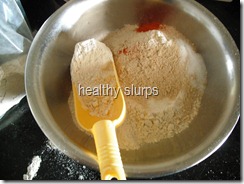
For roti cones
- Rajgira flour – 1 cup
- Whole wheat flour – 1 cup
- Salt – 1/2 tsp
- Red chilli powder – 1/4 tsp (optional)
- Ajwain seeds – 1/4 tsp (optional)
- Fresh water – 1/2 cup + 1 tbsp
- Vegetable oil – 2 tsp
For filling
- Red lobia – 1 cup, rinsed, soaked for 4 hours

- Onion – 1 medium, chopped fine ( had 1/2 cup)
- Garlic – 2 small cloves, minced super fine
- Tomatoes – 2, blanched and pureed
- Vegetable oil – 1 tsp OR Butter melted – 2 tsp
- Red chilli powder – 1/2 tsp
- Cumin powder – 1 tsp
- Oregano – 1 level tsp
- Salt – 1 heaped tsp
- Sugar – 1/2 tsp
For garnish
- Green cucumber – peel, deseed, chopped fine – 1 cup
- Carrot – 1, grated
- Onion – 1 medium, sliced
- Apple cider vinegar – 3 tbsp, to soak the onion slices in
- Cheddar cheese - grated, 2 tbsp or more!
- Pitted olives – 2 tbsp (Optional)
- Iceberg lettuce – shredded, 1/2 cup (optional)
To assemble
For roti cones
Combine all ingredients mentioned under ‘roti cones’ into a dough. The measure of water I have used worked for the brand of whole wheat flour I had. Other brands may need lesser, so add water carefully. Knead well to activate the gluten in wheat flour. Rajgira does not have gluten. (more on that in the nutrition notes)

Make balls of the dough.
Roll into oblong rotis I used whole wheat flour for dusting. The oblong shape worked best for making cones later.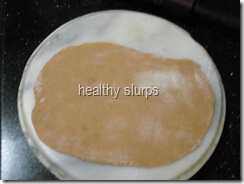
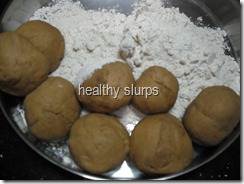
Cook on one side until brown dots appear. Flip and cook the other side too. Smear 1/8 tsp butter / oil on each roti. Make oblong rotis with the rest of the balls, cook similarly. Wrap in a napkin and and set aside.
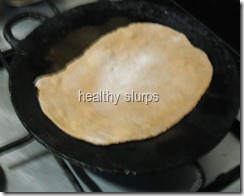
For garnish
Peel, rinse and slice the onion meant for garnish. Soak in 3 tbsp of apple cider vinegar. This turns the onions into a lovely pink hue and also removes the ‘bite’ of onions.
Rinse, peel carrot and grate using medium fine grater.
Rinse, peel, deseed cucumber and chop fine.
Shred cheddar cheese.
Pit olives, slice them thin. (if using)
Rinse lettuce, shred and keep immersed in ice cold water till needed. (if using)
Store each ingredient separately until required.
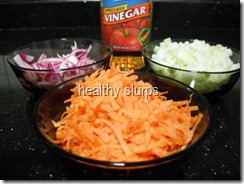
For filling
I followed the recipe for refried beans from Tarla Dalal’s Mexican cookbook. I have substituted rajma with red lobia here and adapted quantities of other ingredients to taste. Here is what I did -
Rinse the soaked lobia. Pressure cook with water enough to cover the top of the lobia. I cooked for 5 minutes after the first whistle of the pressure cooker.
Rinse a couple of tomatoes, blanch and puree them.
Heat oil / butter in a pan.

Tip in minced garlic followed by chopped onions.
When onions turn pink, pour in tomato puree.
When the puree has lost its raw flavour, add sugar, salt, red chilli powder, mix well.
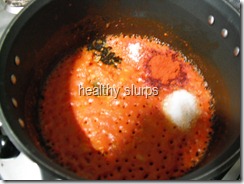
Now is the time to add the cooked lobia. Keep turning in the lobia and mash well with the back of the ladle. Take care not to burn the bottom.
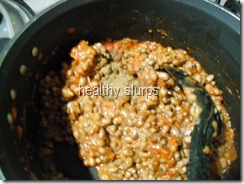
Add the cumin powder, oregano, mix thoroughly. Switch off flame.
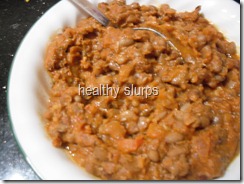
To assemble the conito
Place a rectangular sheet of foil on a plate and place a roti on the foil as in the picture.
Turn the two ends of the roti to form a cone and wrap the foil around the cone, tuck the pointed end of the foil around the roti cone.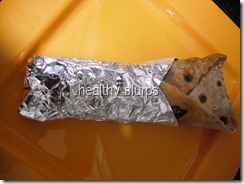
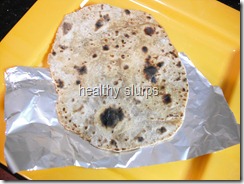
Place a heaped tablespoon of the lobia filling inside the cone.
Top up with shredded lettuce, olives (if using), grated carrots, cucumber and sliced onions. Don’t forget the yummy cheese !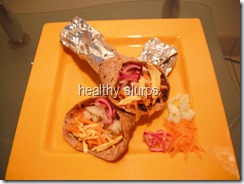
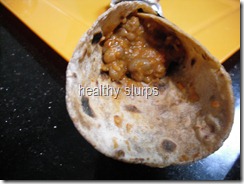
What are you waiting for? Go ahead and enjoy your labour of love!!
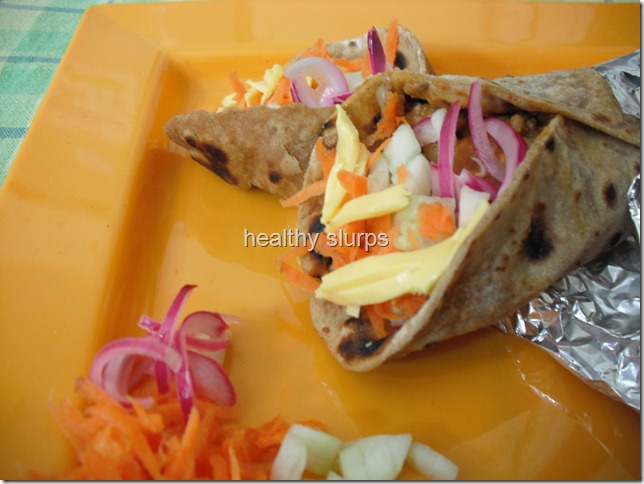

Nutri notes
- By far, the greatest advantage of Rajgira flour is that it is gluten free and hence can be used by people with gluten – intolerance, Celiac disease.
- With 2mg iron / 100gm of Rajgira and 47 mg Calcium / 100gm of flour, Rajgira is an immediate pick me up for adolescents.
- The unique amino acid profile of Rajgira enables it to be a complete food when combined with pulses / legumes. (As in this recipe) The grain has a very high lysine content.
- A low sodium food, hence great for hypertensive people too.
- The flour has a dietary fibre of 9 mg / 100gm, great news for weight watchers, diabetics, cancer, heart disease and anyone with chronic constipation.
- The flour does not contain B complex vitamins. Hence it has to be combined with fresh vegetables / fruits in a meal.
- Rajgira is best consumed cooked as it has some inhibitors ( substances that block absorption of nutrients on body). The flour can also be cooked into a plain porridge.
- The flour has also been found to have significant amounts of phytoesterols,important in building defence mechanisms and improving immunity.


